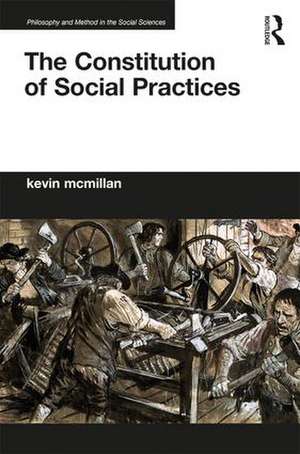The Constitution of Social Practices: Philosophy and Method in the Social Sciences
Autor Kevin McMillanen Limba Engleză Hardback – 16 oct 2017
What would social scientists’ research look like if they took these insights seriously? To answer this question, the book offers an analytical framework to guide empirical research on practices in different times and places. The author explores how practices can be identified, characterised and explained, how they function in concrete contexts and how they might change over time and space.
The Constitution of Social Practices lies at the intersection of philosophy, social theory, cultural theory and the social sciences. It is essential reading for scholars in social theory and the philosophy of social science, as well as the broad range of researchers and students across the social sciences and humanities whose work stands to benefit from serious consideration of practices.
Toate formatele și edițiile
| Toate formatele și edițiile | Preț | Express |
|---|---|---|
| Paperback (1) | 410.46 lei 43-57 zile | |
| Taylor & Francis – 31 ian 2019 | 410.46 lei 43-57 zile | |
| Hardback (1) | 1000.27 lei 43-57 zile | |
| Taylor & Francis – 16 oct 2017 | 1000.27 lei 43-57 zile |
Preț: 1000.27 lei
Preț vechi: 1219.84 lei
-18% Nou
Puncte Express: 1500
Preț estimativ în valută:
191.40€ • 200.37$ • 158.37£
191.40€ • 200.37$ • 158.37£
Carte tipărită la comandă
Livrare economică 07-21 aprilie
Preluare comenzi: 021 569.72.76
Specificații
ISBN-13: 9781138894617
ISBN-10: 1138894613
Pagini: 208
Ilustrații: 7 Line drawings, black and white; 7 Illustrations, black and white
Dimensiuni: 156 x 234 x 20 mm
Greutate: 0.45 kg
Ediția:1
Editura: Taylor & Francis
Colecția Routledge
Seria Philosophy and Method in the Social Sciences
Locul publicării:Oxford, United Kingdom
ISBN-10: 1138894613
Pagini: 208
Ilustrații: 7 Line drawings, black and white; 7 Illustrations, black and white
Dimensiuni: 156 x 234 x 20 mm
Greutate: 0.45 kg
Ediția:1
Editura: Taylor & Francis
Colecția Routledge
Seria Philosophy and Method in the Social Sciences
Locul publicării:Oxford, United Kingdom
Public țintă
Postgraduate and UndergraduateCuprins
List of Figures
Introduction
1 A "Cultural" Approach to Social Science
2 Practice Theory Today
3 Core Ontological Commitments
4 Sketch of the Argument
5 Of Philosophy and Social Science
Chapter 1: What Are Practices?
1 Actions under a Description
2 Looping Effects
3 Historical Constitution
Chapter 2: Knowledge
1 Knowledgeable Practices
2 Conceptualising Knowledge
Chapter 3: Retroactive Redescription
1 The Validity of Retroactive Redescription
2 The Effects of Retroactive Redescription
3 Functional Concepts and Typological Classification;
4 What Is at Stake?
Chapter 4: Identification and Context
1 Identifying Practices "in All Their Specificity"
2 Relations and Relational Properties
3 Criteria of Identification
Chapter 5: Specificity and Generalisation
1 Functions
2 Implications for Generalisation, Explanation and Description
3 Patchwork Holism
Chapter 6: Possibility and Capacities
1 Possibility
2 Capacities
Chapter 7: Constitutive Relations and Constitutive Theory
1 Constitutive Theory
2 Constitutive Relations
3 Stability and Change
Conclusion
1 Culture and Action in the Social Sciences
2 Some Benefits of Studying Practices
Works Cited
Introduction
1 A "Cultural" Approach to Social Science
2 Practice Theory Today
3 Core Ontological Commitments
4 Sketch of the Argument
5 Of Philosophy and Social Science
Chapter 1: What Are Practices?
1 Actions under a Description
2 Looping Effects
3 Historical Constitution
Chapter 2: Knowledge
1 Knowledgeable Practices
2 Conceptualising Knowledge
Chapter 3: Retroactive Redescription
1 The Validity of Retroactive Redescription
2 The Effects of Retroactive Redescription
3 Functional Concepts and Typological Classification;
4 What Is at Stake?
Chapter 4: Identification and Context
1 Identifying Practices "in All Their Specificity"
2 Relations and Relational Properties
3 Criteria of Identification
Chapter 5: Specificity and Generalisation
1 Functions
2 Implications for Generalisation, Explanation and Description
3 Patchwork Holism
Chapter 6: Possibility and Capacities
1 Possibility
2 Capacities
Chapter 7: Constitutive Relations and Constitutive Theory
1 Constitutive Theory
2 Constitutive Relations
3 Stability and Change
Conclusion
1 Culture and Action in the Social Sciences
2 Some Benefits of Studying Practices
Works Cited
Recenzii
"What constitutes "practice theory" is often bewildering. McMillan not only does an excellent job of sorting this out but presents a distinctive original argument for a cultural approach, based on a theory of human action and the philosophy of social science, which is applicable as an approach to empirical studies." - John G. Gunnell, Distinguished Professor, Emeritus, State University of New York, Albany, USA.
"A welcome antidote to the confusion that surrounds the use of the concept of practice in the social sciences today, The Constitution of Social Practices offers a fresh philosophical analysis of this concept and explores its implications across a broad range of empirical fields, thereby adding new clarity and rigor to the study of practices." - Jens Bartelson, Lund University, Sweden.
"A welcome antidote to the confusion that surrounds the use of the concept of practice in the social sciences today, The Constitution of Social Practices offers a fresh philosophical analysis of this concept and explores its implications across a broad range of empirical fields, thereby adding new clarity and rigor to the study of practices." - Jens Bartelson, Lund University, Sweden.
Descriere
This book contends that practices are perhaps the most fundamental building-block of social reality and asks what social scientists’ research would look like if they took this insight seriously. Arguing for the importance of detailed empirical study of human practices to effective social-scientific inquiry, and the centrality to social theory of a well-developed practice theory, the author examines the generic features of human practices, the means by which they can be identified, characterised and explained, how they function and how they might change across time and space.








